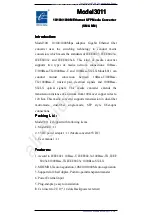
TOSHIBA
9 - 7
9.4
JUMP FREQUENCY GROUP PARAMETERS
JUMP FREQUENCY #1 (ITEM 1) - Use this function to set the beginning point of a
frequency bandwidth to be skipped when running a motor. This function is to be used in
conjunction with the bandwidth which is set by Jump Width #1. This function is to be
used when a certain frequency is to be avoided, such as the resonance frequency of a
loaded machine. Frequency jump does not engage when either accelerating or
decelerating through the programmed frequencies and bandwidths. It does prevent a
frequency setting from running continuously in one of the bandwidths assigned to be
locked out by this procedure.
JUMP WIDTH #1 (ITEM 2) - Use this function to set the bandwidth for Jump
Frequency #1.
JUMP FREQUENCY #2 (ITEM 3) - Use this function to set the beginning point of a
second frequency bandwidth to be skipped when running a motor. This function is to be
used in conjunction with the bandwidth which is set by Jump Width #2. This function
should be used when a second resonant frequency should be avoided.
JUMP WIDTH #2 (ITEM 4) - Use this function to set the bandwidth for Jump
Frequency #2.
JUMP FREQUENCY #3 (ITEM 5) - Use this function to set the beginning point of a
third frequency bandwidth to be skipped when running a motor. This function is to be
used in conjunction with the bandwidth which is set by Jump Width #3. This function
should be used when a third resonant frequency should be avoided.
JUMP WIDTH #3 (ITEM 6) - Use this function to set the bandwidth for Jump
Frequency #3.
PID SETPOINT CONTROL SELECT (ITEM 7) - Use this function to select proportional,
integral, or differential gain (PID) either "on" or "off". This function is to be used in
conjunction with the following functions of Proportional Gain, Differential Gain, and
Integral Gain (See page 10-5).
PROPORTIONAL GAIN (ITEM 8) - Use this function to set the gain of the PID control
input signal.
INTEGRAL GAIN (ITEM 9) - Use this function to adjust the period of integration when
comparing the set point to the feedback signal.
DIFFERENTIAL GAIN (ITEM 10) - Use this function to adjust the differential gain and
stabilize the system when "hunting" occurs.
LAG TIME CONSTANT (ITEM 11) - Use this function to adjust the time of response
when a change in the feedback signal occurs.
efesotomasyon.com -Toshiba inverter,drive,servo,plc
















































